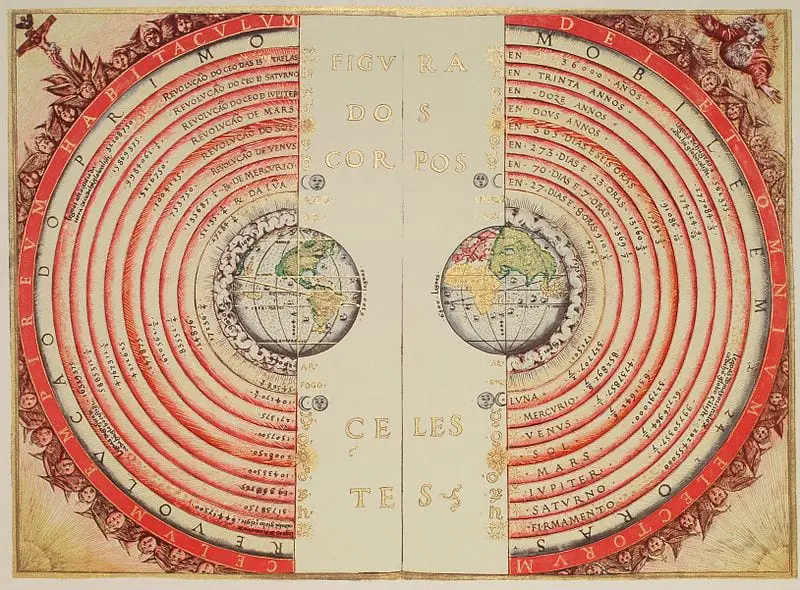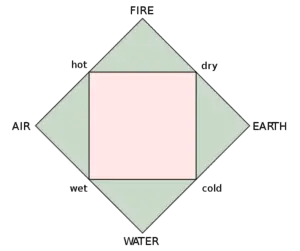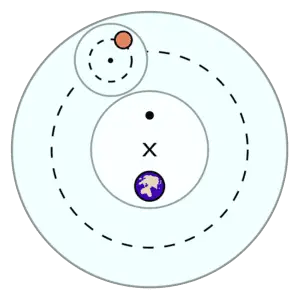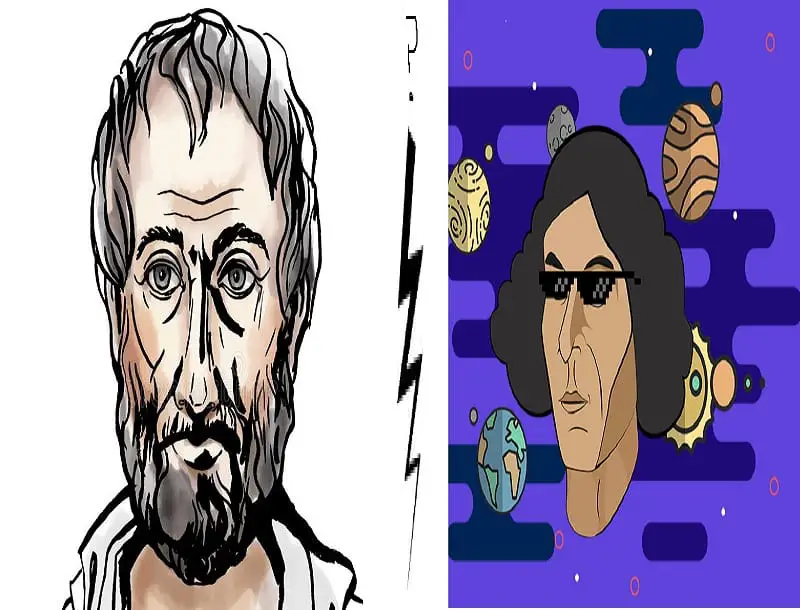Geocentric means sun revolves around earth (earth-centered system) while heliocentric means earth revolves around sun (sun-centered system). In the current world scenario, no one can deny the fact that the earth revolves around the sun.
But, there was a time (almost 5 centuries ago) when the whole world believed that the sun indeed revolves around the earth. Before going into the broad discussion that what revolves around what and on what basis, let me present you a short and crisp review regarding the difference between geocentric and heliocentric models of the solar system.
Geocentrism vs Heliocentrism
| Geocentrism | Heliocentrism | |
| 1. | Developed by Aristotle and company. | Developed by Copernicus and company. |
| 2. | In geocentrism, Earth is the center of the solar system or universe. | In heliocentrism, Sun is the center of the solar system or universe. |
| 3. | Earth is stationary. | Earth is not stationary. |
| 4. | According to the geocentric theory, the sun revolves around the earth in concentric spheres. | According to the heliocentric theory, the earth revolves around the sun in concentric spheres. |
| 5. | Not only the sun, everything else revolves around the earth in concentric spheres. | Not only the earth, everything else (in the solar system) revolves around the sun in concentric spheres. |
| 6. | Apart from the earth, everything else in the universe is made from Aether. | All the celestial objects including the earth are made from earth-like materials. |
| 7. | Stellar Parallax does not exist. | Stellar Parallax does exist. |
| 8. | The retrograde motion of planets is explained using the concept of epicycles. | The retrograde motion of the planets is explained using the concept of Earth’s orbital motion. |
| 9. | The retrograde motion of Mars cannot be explained using the geocentric theory. | The retrograde motion of Mars can be easily explained using the heliocentric theory. |
The above-mentioned difference between the geocentric and heliocentric models is with respect to the Copernicus model of the solar system. That’s why I have written that the earth and everything else in the solar system revolves around the sun in concentric spheres, not in an elliptical motion.
From the above geocentrism vs heliocentrism tabular form, you got the exact overview of these two. However, in order to get to know them in detail, let us try to understand both of them in a detailed format. Keep reading!
What is Geocentric Theory?

As the name suggests, according to the geocentric theory, Earth is the center of the universe. And, all the other planets, stars, sun (everything) revolves around the earth in a circular motion. See the above image for proper understanding. This theory comes in the list of obsolete cosmological theories of the universe.
In Geocentrism, the order of spheres from the Earth outward is as follow:
Not to mention, sometimes people get confused with the fact that how to address geocentrism. I mean, some physicists refer to it as an Aristotelean Universe. Conversely, some refer to it as a Ptolemaic Universe. Well, what to call it?
See, the point is that both ways of referring the geocentrism are factually correct. All you need to know is why the earth-centered universe is referred to as the Aristotelian or Ptolemaic system. And, for that, you should understand the basic physics behind it, Woops, mathematics too.
Geocentrism: Aristotelian Universe or Ptolemaic Universe?
As I said, it’s just a game of physics and mathematics. Confused? Don’t worry! I will tell you how! See, the one and the only difference between them is that the Aristotelian universe defines the physical aspects (physics) of geocentrism.
While, on the other hand, the Ptolemaic Universe outlines the mathematical solutions behind the working of the geocentric theory of the solar system or universe. Therefore, as per utility, the way we refer to it varies.
For example, if I am talking in terms of physics, I will refer to it as the Aristotelian model of the universe. Similarly, if I am talking in terms of mathematics, I will refer to it as a Ptolemaic model of the Universe.
Moreover, if I am talking in terms of both physics and mathematics, I will refer to it as Aristotelian-Ptolemaic Universe.
Aristotelian Universe: Physical Interpretation of Geocentrism
In Aristotelian physics, the universe is largely divided into two distinct spheres. These are terrestrial sphere: a place where humans can live and evolve. And, on the other hand, a celestial sphere: a place where no human can ever reach.

According to the Aristotelian cosmology, only earth constitutes the terrestrial sphere. Therefore, made up of 4 classical elements (Fire, Air, Earth, and, Water). Not to mention, in today’s world, these four classical elements are equivalent to modern chemical elements.
Moving ahead, apart from earth, everything else in this universe constitutes the celestial spheres. As no human can reach the celestial or so-called heavenly spheres, Aristotle, in his treatise On The Heavens mentioned it as an in-corruptable place, hence made of Aether.
Additionally, in the Aristotelian world, our natural satellite i.e the moon has the most important role to play. The moon acts as the divider between the two spheres of the Aristotelian Cosmology.
In other words, the terrestrial sphere lies below the sphere of the moon. Similarly, the celestial spheres lie above the sphere of the moon.
Ptolemaic Universe: Mathematical Interpretation of Geocentrism

A Ptolemaic system is basically a mathematical generalization of the Aristotelian World. In other words, Claudius Ptolemy, in his treatise Amalgest defines the motion of the celestial objects as per geocentrism.
Not only he defined the existing model, he, in fact, modified it to some extent. Unlike Aristotle, he argued that each planet is supposed to be moved by the system of two spheres. See the above image for proper understanding.
He called the first sphere the Deferent: a circle whose center point is removed from the earth. He used the deferent to explain the change in the length of the seasons. Similarly, he called the second sphere an epicycle, which he used to explain the retrograde motion of the planets.
Must read, Copernican Model: Slayer of the Earth-Centered Universe
Even after the modification done by Ptolemy, there were some notable errors that had deeply troubled the astronomers and physicists of that time. Some of the errors include the retrograde motion of the mars, the phenomenon of stellar parallax, etc.
Regarding stellar parallax, Ptolemy used to argue that if Earth is actually revolving around the sun. Then, as a result, there has to be the observation of stellar parallax, which was simply not possible at that time.
WHY? Because there was no telescope. Hence, astronomers had to take observation through the naked eyes.
What is Heliocentric Theory?

As the name suggests, according to the heliocentric theory, Sun is the center of the solar system. And, all the other planets including earth revolves around the sun in a circular motion.
Obviously, you would be thinking that why I said circular motion, not elliptical motion. Well, allow me to clear the air around the two.
See, the point is that when I am referring to heliocentric theory as Copernican heliocentrism, I am talking in terms of the circular motion of planets around the sun.
In other words, the Copernicus model of the solar system is the outdated version of the solar system.
On the other hand, when I am referring to heliocentric theory as Kepler’s heliocentrism, I am talking in terms of the elliptical motion of the planets around the sun.
In other words, Kepler’s laws of planetary motion or Kepler’s heliocentrism is the current or prevailing version of the solar system.
In the Sun-Centered Solar system, the order of spheres from the Sun outward is as follow:
Errors in Copernican Heliocentrism

Not to mention, there were some notable errors in the Copernican model. Therefore, as a result, Kepler’s heliocentrism or Kepler’s laws of planetary motion superseded the Copernican heliocentrism.
In other words, just because Copernicus used circular motion, the Copernican heliocentrism drastically failed to explain why planets revolve around the sun at different speeds at different locations.
Kepler, therefore, by replacing the circular orbits with the elliptical ones, of course, with the help of Tycho Brahe’s Work, showed that how planets speed up at certain points in their orbits and slowed down at others.
Just to give you a brief presentation, let me explain the difference between them in a tabular form.
Copernican Heliocentrism vs Keplerian Heliocentrism
| Copernican Heliocentrism | Keplerian Heliocentrism | |
| 1. | Developed by Nicolaus Copernicus. | Developed by Johannes Kepler. |
| 2. | In Copernican heliocentrism, all planets revolve around the sun in circular orbits. | In Keplerian heliocentrism, all planets revolve around the sun in an elliptical orbit. |
| 3. | According to the Copernican model, the sun is located at the center of the circular orbits. | According to the Keplerian model, the sun is located at one of the foci of an elliptical orbit. |
| 4. | In Copernican heliocentrism, the speed of the planets in an orbit remains constant. | In Keplerian heliocentrism, the speed of the planets is not constant, but the area speed is constant. |
That’s it for this post. If you like this article, share it if you like it, like it if you share it. You can also find us on Mix, Twitter, Pinterest, and Facebook.
You might also like:
- Difference Between Mass and Weight (Tabular Form)
- Difference Between Scalar and Vector (Tabular Form)
- EPR Paradox, a Thought, Myth, or, a Reality?

Greetings, Atul, The opportunity is yours to be remembered in India, in the Hindu community, and in the world to be the person who championed the revised model of Heraclides Ponticus. Blessings